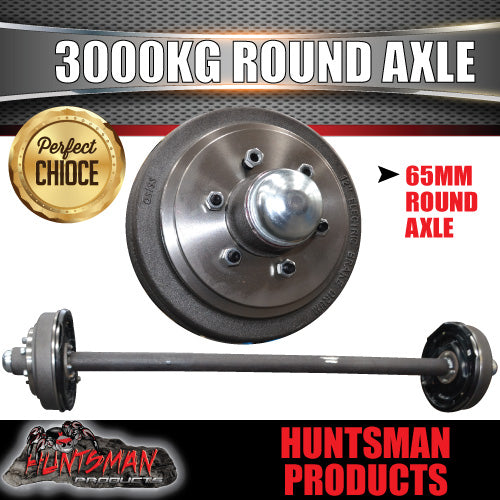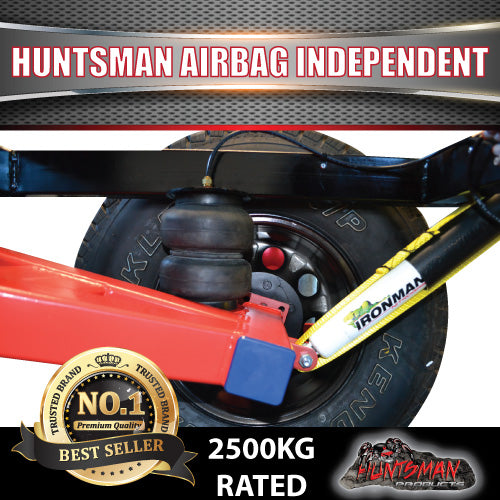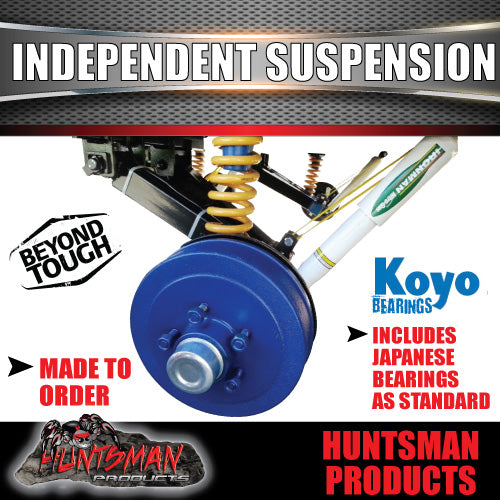Hey guys,
Looking for some advice regarding custom building a camper trailer potentially using 80 series suspension/design/parts.
Just FYI these these are the requirements/aim or the trailer:
1. Internal flushing toilet/bathroom.
2. Internal shower with onboard hot water burner (probably using propane/LPG)
3. Stove/burner hooked up to propane/LPG tank.
4. Ability to carry decent amount of firewood
5. Ability to carry a decent amount of water (even a short distance), maybe 200-400 litres.
6. Good ground clearance/ability to go down 4WD tracks.
So basically when going on camping trips with the misses she wants the ability to have a shower and have a proper toilet with no spiders/snakes (which is a real problem here in Aus). Now normally i would look to camp near a river for water supply, but would like the ability to pump on a bunch of water when near a stream to carry to a dedicate campsite. Likewise the ability to carry enough firewood for a night or two. So weights could vary from say 1000kg to 2500kg+ fully loaded for short periods.
So I will be custom building the entire trailer from scratch. It will be using a proper offroad hitch, electric trailer brakes with break away stop function. Where i need help is with the design of the suspension/axle. These are the 4 options I am considering...
Solid Axle Version
So the following 3 options would be using this solid axle:

 www.huntsmanproducts.com.au
www.huntsmanproducts.com.au

(I did consider using an actual 80 series axle which would make life easier, but means a bit less ground clearance, a bunch of work to fit the electric trailer brakes and potentially a bit harder to get registered/approved. Even though this axle isn't exactly cheap, its a certified solution and they will fabricate it to match my 80 series track width which saves me a bunch of time).
1. Basic leaf spring design (the same as pretty much any other trailer) with added shocks.
Advantages is its relatively cheap and very reliable, very high carrying capacity (3000kg). Fairly light weight relatively speaking
Disadvantage is the springs would be setup for one specific weight, not easily adjustable. Very bouncy ride
2. Build a triangulated 4 link setup using the axle above utilising standard 80 series rear upper/lower control arms (I have a set of standard ones left over from a build, so no additional cost). Couple this with airbag suspension and decent shocks.
Advantages is its relatively cheap, should be pretty reliable, very high carrying capacity, airbags can be adjusted for varying weights.
Disadvantage is ride quality will be average, may have less clearance from the upper control arms to the trailer floor? Could be reasonably heavy
3. Build a 3 link setup utilising 80 series front control arms (but flipped around so they mount over the top of the axle with the "chassis" end at the front of the trailer. Use airbags with shocks.
Advantages is its relatively cheap and should be pretty reliable, very high carrying capacity, airbags can be adjusted for varying weights, should also have better clearance than a triangulated 4 link.
Disadvantage is the ride quality will be average? Probably the heaviest solution.
4. Purchase a heavy duty independent suspension setup like this one below:

 www.huntsmanproducts.com.au
www.huntsmanproducts.com.au

Advantages is it'll give the best ride quality (maybe?), Is less fabrication work for me, can adjust the airbags to suit weight, proven design, better ground clearance (maybe?)
Disadvantage is cost (I could probably build the other setups for around $1500aud, this one is $3600...), load carrying capacity is slightly less but still probably more than enough. The shock angle in this design isn't ideal...
5. Purchase a medium duty independent suspension setup like this one below:

 www.huntsmanproducts.com.au
www.huntsmanproducts.com.au

Advantages is it'll give good ride quality, less fabrication work for me, proven design and better ground clearance. Cheaper than the heavy duty option above.
Disadvantage is the springs cant be adjusted for changing weight. Load capacity is low, shock angel isn't great, still fairly expensive ($2200aud)
So i am open to ideas/suggestions. I am a pretty good fabricator and like the idea of building a 3link/4link setup just for the experience. That said, I don't want to go to the effort of building something that doesn't work or needs modifications.
Cheers,
Looking for some advice regarding custom building a camper trailer potentially using 80 series suspension/design/parts.
Just FYI these these are the requirements/aim or the trailer:
1. Internal flushing toilet/bathroom.
2. Internal shower with onboard hot water burner (probably using propane/LPG)
3. Stove/burner hooked up to propane/LPG tank.
4. Ability to carry decent amount of firewood
5. Ability to carry a decent amount of water (even a short distance), maybe 200-400 litres.
6. Good ground clearance/ability to go down 4WD tracks.
So basically when going on camping trips with the misses she wants the ability to have a shower and have a proper toilet with no spiders/snakes (which is a real problem here in Aus). Now normally i would look to camp near a river for water supply, but would like the ability to pump on a bunch of water when near a stream to carry to a dedicate campsite. Likewise the ability to carry enough firewood for a night or two. So weights could vary from say 1000kg to 2500kg+ fully loaded for short periods.
So I will be custom building the entire trailer from scratch. It will be using a proper offroad hitch, electric trailer brakes with break away stop function. Where i need help is with the design of the suspension/axle. These are the 4 options I am considering...
Solid Axle Version
So the following 3 options would be using this solid axle:

3000KG Axle. 12" Electric Braked 65mm Round. L/C Pattern
The Huntsman products 3000kg axle is manufactured from 65mm solid steel. This axle comes with landcruiser size bearings and also has handbrake levers
(I did consider using an actual 80 series axle which would make life easier, but means a bit less ground clearance, a bunch of work to fit the electric trailer brakes and potentially a bit harder to get registered/approved. Even though this axle isn't exactly cheap, its a certified solution and they will fabricate it to match my 80 series track width which saves me a bunch of time).
1. Basic leaf spring design (the same as pretty much any other trailer) with added shocks.
Advantages is its relatively cheap and very reliable, very high carrying capacity (3000kg). Fairly light weight relatively speaking
Disadvantage is the springs would be setup for one specific weight, not easily adjustable. Very bouncy ride
2. Build a triangulated 4 link setup using the axle above utilising standard 80 series rear upper/lower control arms (I have a set of standard ones left over from a build, so no additional cost). Couple this with airbag suspension and decent shocks.
Advantages is its relatively cheap, should be pretty reliable, very high carrying capacity, airbags can be adjusted for varying weights.
Disadvantage is ride quality will be average, may have less clearance from the upper control arms to the trailer floor? Could be reasonably heavy
3. Build a 3 link setup utilising 80 series front control arms (but flipped around so they mount over the top of the axle with the "chassis" end at the front of the trailer. Use airbags with shocks.
Advantages is its relatively cheap and should be pretty reliable, very high carrying capacity, airbags can be adjusted for varying weights, should also have better clearance than a triangulated 4 link.
Disadvantage is the ride quality will be average? Probably the heaviest solution.
4. Purchase a heavy duty independent suspension setup like this one below:

2500KG Off road Camper Trailer Caravan Air Bag Independent Suspension
The Huntsman independent suspension is the perfect go anywhere kit for your caravan or off road trailer. this kit comes rated at 2500kg and will incorporate electric brakes. with the shock and air bag setup it offers a fantastic smooth ride
Advantages is it'll give the best ride quality (maybe?), Is less fabrication work for me, can adjust the airbags to suit weight, proven design, better ground clearance (maybe?)
Disadvantage is cost (I could probably build the other setups for around $1500aud, this one is $3600...), load carrying capacity is slightly less but still probably more than enough. The shock angle in this design isn't ideal...
5. Purchase a medium duty independent suspension setup like this one below:

2000Kg Off Road Camper Trailer Caravan Independent Suspension. Ironman Shocks
The Huntsman independent suspension is the perfect go anywhere kit for your caravan or off road trailer. this kit comes rated at 2000kg and will incorporate alko off roade brakes. with the shock and coil setup it offers a fantastic smooth ride.
Advantages is it'll give good ride quality, less fabrication work for me, proven design and better ground clearance. Cheaper than the heavy duty option above.
Disadvantage is the springs cant be adjusted for changing weight. Load capacity is low, shock angel isn't great, still fairly expensive ($2200aud)
So i am open to ideas/suggestions. I am a pretty good fabricator and like the idea of building a 3link/4link setup just for the experience. That said, I don't want to go to the effort of building something that doesn't work or needs modifications.
Cheers,
Last edited:



